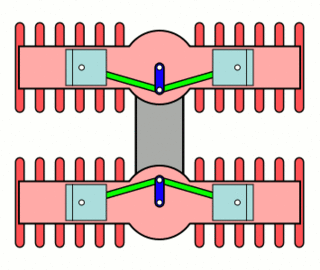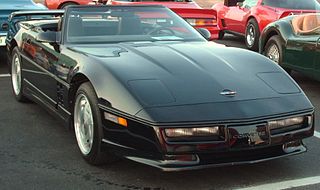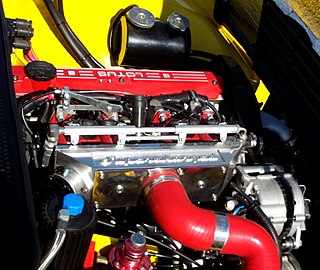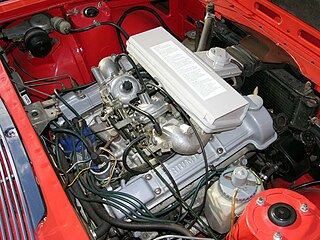
Pontiac or formally the Pontiac Motor Division of General Motors, was an American automobile brand owned, manufactured, and commercialized by General Motors. Introduced as a companion make for GM's more expensive line of Oakland automobiles, Pontiac overtook Oakland in popularity and supplanted its parent brand entirely by 1933.

The straight-six engine is a piston engine with six cylinders arranged in a straight line along the crankshaft. A straight-six engine has perfect primary and secondary engine balance, resulting in fewer vibrations than other designs of six or less cylinders.

An H engine is a piston engine comprising two separate flat engines, most often geared to a common output shaft. The name "H engine" is due to the engine blocks resembling a letter "H" when viewed from the front. The most successful "H" engine in this form was the Napier Dagger and its derivatives. The name was also applied to engines of the same basic layout, but rotated through 90 degrees—most famously the Napier Sabre series. A variation on the "H" theme were the Fairey Prince (H-16) & Fairey P.24 Monarch, where the two engines retained separate drives, driving Contra-rotating propellers through separate concentric shafts. Although successful, they only existed in prototype form.

The Vauxhall Chevette is a supermini car that was manufactured by Vauxhall in the United Kingdom from 1975 to 1984. It was Vauxhall's version of the "T-Car" small-car family from Vauxhall's parent General Motors (GM), and based primarily on the Opel Kadett C. The family also included the Isuzu Gemini in Japan, the Holden Gemini in Australia, the Chevrolet Chevette in the United States, Canada, Brazil, Colombia, Ecuador and Argentina, and in the U.S. and Canada it was also rebadged as the Pontiac Acadian/Pontiac T1000.

The Vauxhall Slant-4 is an inline four-cylinder petrol car engine manufactured by Vauxhall Motors. Unveiled in 1966, it was one of the first production overhead camshaft designs to use a timing belt to drive the camshaft. The Slant-4 block was used as a development mule for the Lotus 900 series of engines. Vauxhall used the engine in a variety of models until production ended in 1983.

The Saab 9-3 is a compact executive car initially developed and manufactured by the Swedish automaker Saab.

The Saab 99 is a car which was produced by Saab from 1968 to 1984; their first foray into a larger class than the 96. While considered a large family car in Scandinavia, it was marketed as a niche compact executive car in most other markets. It was manufactured both in Sweden and Finland and was succeeded by the Saab 900, although the 99 continued to be produced alongside its successor. The Saab 90, an updated, less complex version using many 900 parts took over from the 99 in late 1984.

The Triumph Stag is a 2+2 sports tourer which was sold between 1970 and 1978 by the Triumph Motor Company, styled by Italian designer Giovanni Michelotti.

The Pontiac Fiero is a rear mid-engine, light sports car manufactured and marketed by Pontiac for model years 1984–1988. Designed by George Milidrag and Hulki Aldikacti as a sporty, daily-drivable car, it was the first two-seater Pontiac model since their 1926 to 1938 coupes, and the first rear mid-engine mass-produced car by any American manufacturer. Innovative chassis and structure technology combined with non load-bearing, composite body-panels, for a light-weight design of the Fiero. Unique for its time, selling several hundred-thousand light Fieros with small 4- and 6-cylinder engines, helped Pontiac greatly towards meeting America's 'CAFE' average fuel economy laws at the time.
The GM Ecotec engine, also known by its codename L850, is a family of all-aluminium inline-four engines, displacing between 1.4 and 2.5 litres. While these engines were based on the GM Family II engine, the architecture was substantially re-engineered for the new Ecotec application produced since 2000. This engine family replaced the GM Family II engine, the GM 122 engine, the Saab H engine, and the Quad 4 engine. It is manufactured in multiple locations, to include Spring Hill Manufacturing, in Spring Hill, Tennessee while the engine block and cylinder heads are cast at Saginaw Metal Casting Operations in Saginaw, Michigan.

The Y platform, or Y body, designation has been used twice by the General Motors Corporation to describe a series of vehicles all built on the same basic body and sharing many parts and characteristics. The first was for a group of entry-level compacts including the conventional front-engine compacts built by GM divisions Buick, Oldsmobile and Pontiac from 1961 to 1963. The second, and current, incarnation is used for a high-end rear-wheel drive sports-car platform from the 1970s through the 2000s.

The Pontiac LeMans is a model name that was applied to subcompact- and intermediate-sized automobiles marketed by Pontiac from 1961 to 1981 and 1988-1993 model years. Originally a trim upgrade based on the Tempest, it became a separate model. In 1964 the Tempest was available with an optional GTO package that later became a separate model, the Pontiac GTO, muscle car. 1970 introduced the GT-37 package.

The Triumph slant-four is an inline four-cylinder petrol car engine developed by the Triumph Motor Company. It first appeared in 1968 in the Saab 99. The first Triumph model to use the engine did not appear until 1972. With an original capacity of 1.7 L, displacement grew over time to 2.0 L. Triumph production ended in 1981.

The Saab B engine is an inline four-cylinder car petrol engine developed by Saab Automobile. A redesign of the Triumph slant-four engine, the B engine displaced 2.0 L and first appeared in 1972. The B engine was used in the Saab 99 and 900 models. Saab began to phase the engine out in 1981.

The Saab H engine is a redesign of the Saab B engine, which in turn was based on the Triumph Slant-4 engine.

The Lotus 900 series is a family of internal combustion engines designed and built by Lotus Cars of United Kingdom. Successor to the Lotus-Ford Twin Cam, the 900 was the first complete engine developed by Lotus. The engine was built from 1972 to 1999.

The International Harvester Scout is an off-road vehicle produced by International Harvester from 1961 to 1980. A precursor of more sophisticated SUVs to come, it was created as a competitor to the Jeep, and it initially featured a fold-down windshield. The Scout and second-generation Scout II were produced in Fort Wayne, Indiana, as two-door trucks with a removable hard top with options of a full-length roof, half-cab pickup, and/or soft top.
The Saab V8 is a V8 engine developed for Saab Automobile by Saab-Valmet. Only five prototype engines were built, with one being extensively road tested. The V8 engine was never put into production.

The Triumph V8 is a 3.0 litre V8 developed and built by the Triumph Motor Company for the Triumph Stag. The engine was a development of the Triumph slant-four engine. It consisted of a cast iron block and aluminium cylinder heads with a single overhead cam per bank.
















